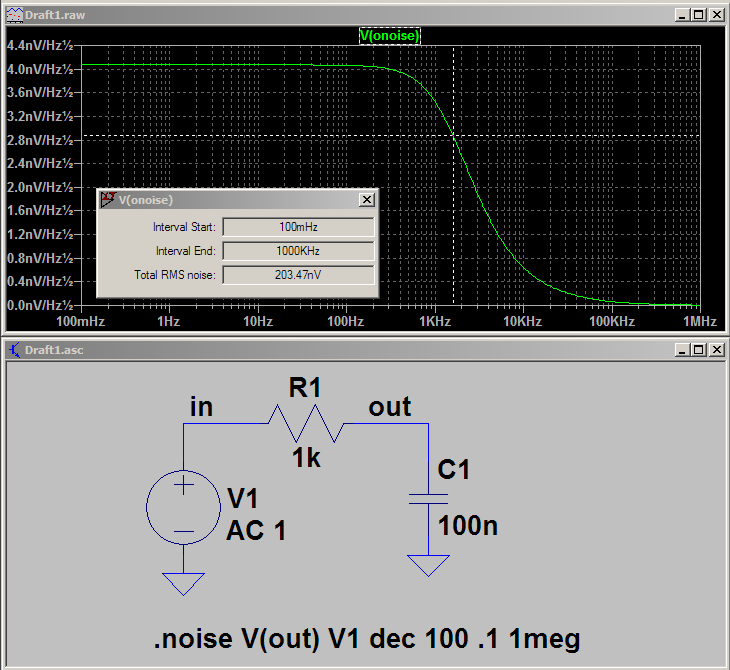I would like to know how to calculate the SNR after a RC filter (let's say 1k-100nF as example). My input signal is 0.5Vrms, and the noise of the signal is 1mVrms, that's give me SNR = 54dB. But what is the "filtered noise" after the RC filter? After some research, I just found the "Equivalent Noise Bandwidth" that not really help me. How to calculate the noise at the RC output filter? Thanks
2 Answers
One thing you don't specify is the noise type (white, digital clock, flicker, ...). A spectrum analyzer is handy for determining the characteristics of the noise.
If the noise is broadband, what is the bandwidth of the noise before filtering? You need to know the bandwidth so you can normalize the noise power to a 1 Hz bandwidth (noise spectral density).
To calculate noise voltage spectral density of your input signal, you need to know the bandwidth of your noise signal.
$$ e_n = {e_{nt} \over \sqrt{ENBW}} $$
Where:
\$ e_n \$ = noise voltage spectral density (noise voltage in a 1 Hz bandwidth)
\$ e_{nt} \$ = total noise in a given bandwidth. In your example, 1 mVrms.
\$ ENBW \$ = equivalent noise bandwidth. In your example, unknown.
With your simple R-C single-pole low-pass filter with a corner frequency of 1592 Hz \$ \left( 1 \over {2 \pi R C} \right)\$, the filter will have an equivalent noise bandwidth of 1.57 times the filter bandwidth, or about 2.5 kHz. With this information the noise voltage at the output of your filter can be calculated. $$ e_{nt} = e_n \sqrt{ENBW} = e_n \sqrt{2500} $$ Since \$ e_n \$ of your unfiltered signal is unknown, I'll leave the rest for you to figure out since there isn't enough information.
There is one other noise source and that's the thermal (Johnson) noise of the resistor in your filter. Resistor noise voltage spectral density is
$$ e_n = \sqrt{4 k_B T R} $$
Where
\$ k_B \$ = Boltzmann's constant
\$ T \$ = absolute temperature in kelvin
\$ R \$ = resistance (real)
At room temperature \$ e_n \approx 0.13 \sqrt{R} \quad nV/\sqrt{Hz} \$
The 1k resistor in your filter produces about 4 \$nV/\sqrt{Hz}\$, or about 200 nVrms of total noise at the output of the filter.
Just for fun, a SPICE simulation of the resistor noise of the filter:

To be complete, the resistor noise must be added to your source noise. The resistor noise of the filter will probably be insignificant for your case. Summing uncorrelated noise $$ e_{nt}^2 = e_{n1}^2 + e_{n2}^2 + e_{n3}^2 + ... + e_{ni}^2 $$
-
\$\begingroup\$ Thank you for your answer. So my output noise after filtering is equal to $$e_{af} = e_{inputnoise}*\sqrt{ENBW} = 10^{-3}*\sqrt{2500}=0.05Vrms$$. The total output noise is equal to $$e_{ton} =\sqrt{e_{res}^2+e_{af}^2}=\sqrt{4*10^{-9}^2+0.005^2=0.005VRMS}$$ And so the SNR after filtering is equal to 20*log10(0.001/0.005)=-13dB. Whats going on? Whats wrong? \$\endgroup\$– LushCommented Feb 20, 2022 at 7:37
-
\$\begingroup\$ You need to know the noise bandwidth of your input signal so you can calculate the spectral density of your input noise. Without this number, all you can do is empirically determine the output noise. You need to keep in mind the bandwidth of your measuring equipment as this may be affecting your measurement of your input noise. It's best to have a spectrum analyzer that reads out noise voltage spectral density (nV/sqrt(Hz). "Low-noise Electronic System Design", by Motchenbacher, is a good resource for learning about noise. \$\endgroup\$– qrkCommented Feb 20, 2022 at 8:14
When you model your SNR, you suppose white noise so you can just use
N=kTW formula, where T is temperature in Kelvins, W is yuor new bandwidth and k is Boltsman constant.
This is equal to multiplying filter frequency response to noise spectre (that is same on all frequencies) by points. And then integrate it through new noise spectre limits and amplitude.
But it is to say that filter will add noise in your bandwith equal to its supression (in dB). So if, for example, your filter supress your signal on 3dB, noise will increase on 3dB
Completion:
Excuse me, I've made a littli bit confusion, though was saying right words.
Mathematical white noise has infinite power, so we usually talk about pseudowhite noise, that means it has cutted spectre, but with equal speсеtral density.
Answering your question:
N2=N1*(W2/W1)
where W2 is bandwidth of brick filter (ENBW), and W1 is BW of your channel.
ENBW will help you to correctly design real filter from this ideal one.
-
\$\begingroup\$ Ok, thanks, I get it. But, with this information, what is the output noise? \$\endgroup\$– LushCommented Feb 19, 2022 at 19:19
-

After some research, I just found the "Equivalent Noise Bandwidth" that not really help me.- then you probably misunderstood it because, as far as I'm aware it is the definitive way to calculate the RMS noise coming from filtered white noise. So, if the filter is a single order type, the effective noise bandwidth is 1.57 x the 3 dB frequency of the filter. \$\endgroup\$